九年级英语unit13教案
- 格式:docx
- 大小:19.22 KB
- 文档页数:16

Unit 13 We are trying to save the earth!Section A (Grammar Focus-4c)1. 语言知识目标:1) 学习掌握下列词汇:cream, workday, pie, show up, bean, market, bythe end of2) 进行一步复习巩固学习Section A 部分所学的生词和词组。
3) 巩固过去完成时的用法2. 能力目标:1) 能运用所掌握的语法,句型和词汇进行交流。
2) 能比较流利地讲述自己曾经有的特别的经历。
1) 复习巩固Section A 部分所学的生词和词组,达到熟练运用的目标。
2) 总结过去完成时的不同句型。
3) 总结过去完成时的用法。
过去完成时的用法. Revision1. Check if you know these phrases.①不同种类的污染②河底③把垃圾扔到河里④在……中起作用⑤在中国南部⑥对……有害⑦在……顶部⑧海洋生态系统2. Translate these sentences into English.①甚至是河底都满是垃圾。
②这个方法不仅残酷还对环境有害。
③鲨鱼处于海洋食物链的顶部。
④许多人相信鱼翅对健康有好处。
II. Grammar FocusPay attention to the sentences.1) We’re trying to save the earth.2) The river used to be so clean.3) The air is badly polluted.4) No scientific studies have shown that shark fins are good for health.5) We should help save the sharks.1. 现在进行时: Present Progressive定义:表示说话时(瞬间)正在进行的动作,也表示目前或现阶段一直进行的动作。
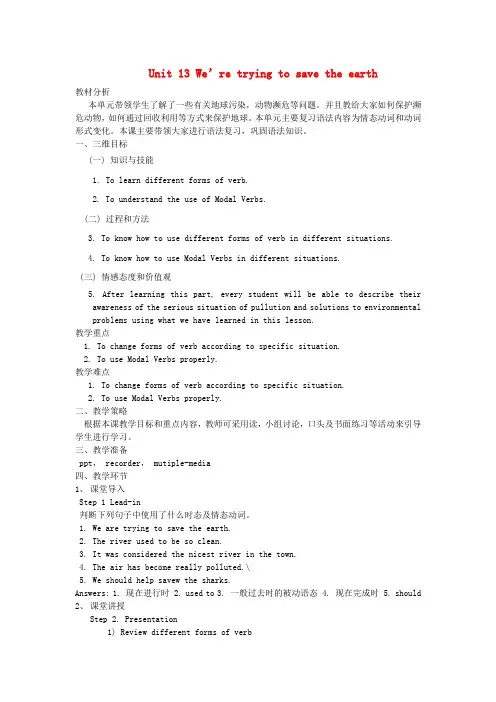
Unit 13 We’re trying to save the earth教材分析本单元带领学生了解了一些有关地球污染,动物濒危等问题。
并且教给大家如何保护濒危动物,如何通过回收利用等方式来保护地球。
本单元主要复习语法内容为情态动词和动词形式变化。
本课主要带领大家进行语法复习,巩固语法知识。
一、三维目标(一) 知识与技能1. To learn different forms of verb.2. To understand the use of Modal Verbs.(二) 过程和方法3. To know how to use different forms of verb in different situations.4. To know how to use Modal Verbs in different situations.(三) 情感态度和价值观5. After learning this part, every student will be able to describe theirawareness of the serious situation of pullution and solutions to environmental problems using what we have learned in this lesson.教学重点1. To change forms of verb according to specific situation.2. To use Modal Verbs properly.教学难点1. To change forms of verb according to specific situation.2. To use Modal Verbs properly.二、教学策略根据本课教学目标和重点内容,教师可采用读,小组讨论,口头及书面练习等活动来引导学生进行学习。
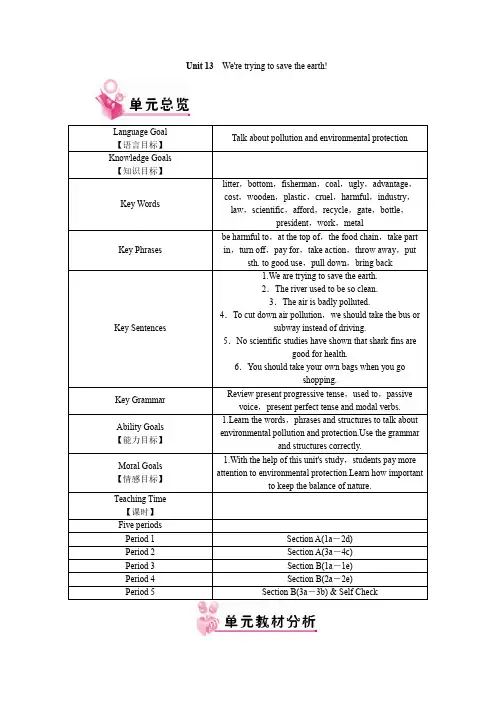
Unit 13We're trying to save the earth!本单元围绕环境保护的话题,并用主题图片表现噪音污染、空气污染、水污染等内容,目的是为了让学生对环境的破坏有一个直观的认识,从而激发学生强烈的社会责任感和对未来发展的思考。
Section A的重点是让学生掌握与环境污染和环境保护相关的词汇和句型,同时引导学生关爱动物、保护环境。
教学难点是让学生学会正确使用连词和结合生活实际讲述如何保护环境。
Section B在Section A所学的基础上,进一步谈论如何保护环境。
教学重点是让学生了解环境保护的方式,并落实到积极的行动当中,同时还有阅读策略和写作技巧的训练。
教学难点是让学生在阅读2a文章之后,根据所给词根找出衍生出的不同词汇,并理解前缀和后缀的不同用法。
The First Period—Section A(1a-2d)Teaching Important Points【教学重点】Key words & phrases:litter,bottom,fisherman,coal,ugly,advantage,cost,wooden,plasticnoise pollution,air pollution,water pollution,be full of,play a part in,turn…into,cut down air pollutionKey sentences:1.Even the bottom of the river was full of rubbish.2.It used to be so clean.3.Everyone in this town should play a part in cleaning it up.4.The air is badly polluted because there are more cars on the road these days.5.The air has become really polluted around here.6.We're trying to save the earth.Key structure:should+do;used to+do;have/has+done;be+done;be+doinge.g.Everyone should help to clean up the river.The air has become really polluted.I used to be able to see stars in the sky.The air is badly polluted.Teaching Difficult Points【教学难点】★Practice the structures to talk about pollution and environmental protection.Teaching Aids【教学工具】A tape recorder,CAI or multimedia courseware.Teaching Steps【教学过程】★Step 1Leading in【新课导入】1.Greeting2.Discussion and reviewDiscuss with the students,like this:T:What kinds of pollution are there these days?S:…T:What causes the pollution?S:…3.Review the words and expressions about the topic.★Step 2Cooperative inquiry【合作探究】1.Finish the task in 1a①Show pictures or play videos about pollution and talk about the pollution.②Read these phrases in 1a.Look at the pictures in 1a and say what they see in the pictures.Write down the words and add more words.③Ask students to say out their words in each kind of pollution.2.Finish the task in 1b①Read the instructions.Get the students to read the contents in the chart and think of what they will fill in the blanks.②Play the recording for the first time.Students listen and fill in the words.③Play the recording a second time.Ask them to check the answers.Then ask the questions.Students answer with full sentences.④Ask more questions to help students learn more details.Then play the recording for the students to role-pay the conversation.3.Finish the task in 1c①Show the key words of the conversation.Ask students to retell the contents in the chart.Like this:What:dirty;bottom,rubbish;fishWhy:littering,putting wasteHow:write to,close down;help to clean up②Read aloud the model dialogue in 1c.Then in pairs,do the oral practice with more words.③Ask two pairs to perform in class.4.Finish the tasks in 2a-2b①Use PPT or pictures to show the four kinds of pollution.Get the groups of students to havea competition to say words about the pollution one by one.land pollution:…air pollution:…noise pollution:…water pollution:…②Get the students to write down these words in their notebooks.③Play the recording for the first time.Students listen and circle the kinds of pollution.Check answers with the class.④Read the sentences in 2b.Predict the contents they will fill in.Play the recording.Students listen and complete the sentences.⑤Play the recording again.Check the answers with the whole class.5.Finish the task in 2c①Read the sample conversation in 2c.Then Read the listening materials and discuss in pairs what causes the two kinds of pollution.②Students work in pairs,making dialogues.③Ask three pairs to role-play their conversations to the class.6.Finish the task in 2d①Talk about the picture in 2d.Ask:What are your ideas for solving the air pollution/waste pollution problem?Present the new words in the conversation.Such as,coal,advantage,wooden,plastic,takeaway,bin,…②Read the conversation in 2d quickly.Find out the problems about environmental pollution in the dialogue.③Read the conversation again.Ask the students to find the ways to solve the problems of air and waste pollution.④Read aloud the conversation by the recording.⑤Learn the useful expressions:What are your ideas for doing…To cut down air pollution,we should…So together,our actions can make a difference and…⑥Role-play or read the conversation in pairs until fluently.★Step 3Homework1.What are your ideas for solving the waste pollution problem?2.Write the words about the four kinds of pollution.3.Translate the following sentences into English.(1)我们正在想办法拯救地球。
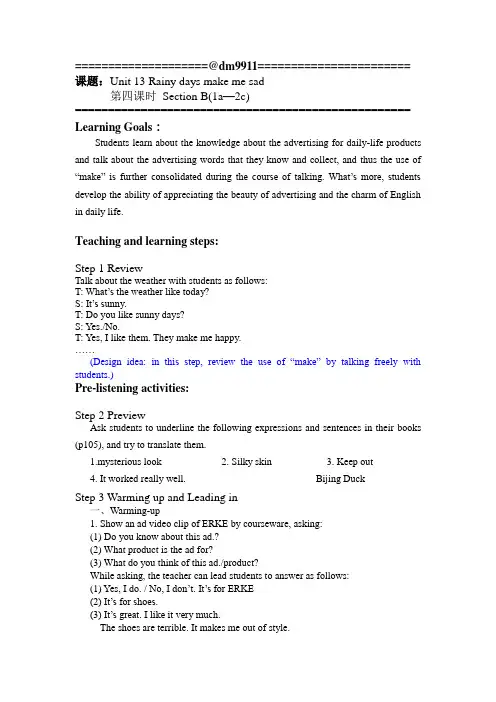
====================@dm9911======================= 课题:Unit 13 Rainy days make me sad第四课时Section B(1a—2c)=================================================== Learning Goals:Students learn about the knowledge about the advertising for daily-life products and talk about the advertising words that they know and collect, and thus the use of “make” is further consolidated during the course of talking. What’s more, students develop the ability of appreciating the beauty of advertising and the charm of English in daily life.Teaching and learning steps:Step 1 ReviewTalk about the weather with students as follows:T: What’s the weather like today?S: It’s sunny.T: Do you like sunny days?S: Yes./No.T: Yes, I like them. They make me happy.……(Design idea: in this step, review the use of “make” by talking freely with students.)Pre-listening activities:Step 2 PreviewAsk students to underline the following expressions and sentences in their books (p105), and try to translate them.1.mysterious look__________2. Silky skin __________3. Keep out _______4. It worked really well. _________________________ Bijing Duck _________ Step 3 Warming up and Leading in一、Warming-up1. Show an ad video clip of ERKE by courseware, asking:(1) Do you know about this ad.?(2) What product is the ad for?(3) What do you think of this ad./product?While asking, the teacher can lead students to answer as follows:(1) Yes, I do. / No, I don’t. It’s for ERKE(2) It’s for shoes.(3) It’s great. I like it very much.The shoes are terrible. It makes me out of style.(Design idea: In this activity, the video clip will be able to intrigue the studentsand focus their attention.)2. Show some pictures in which there are products and slogans.While showing, talk about the pictures as follows:It’s an advertisement for ... I like/dislike it. The slogan is … and the product is … It makes me …(Design idea: This activity will lead naturally in to activity 1a.)二、Presentation1. Activity 1aAsk students to match the slogans with the products.Answers: 4 3 1 22. Activity 1bSay: Make a list of three products you don’t like.While-listening Activities:Step 4 Listening for the main ideaSay: What are they talking about in the conversation?A. ShampooB. CreamC. Some sunglassesD. Some products (Keys: D)Play the recording for students to get the main idea.(Design idea: Let students feel the conversation on the whole.)Step 5 Listening for the specific ideas1. 2a: Ask students to write “Yes” or “No” for “like” or “dislike” next to the products according to the recording.ProductsNo 1. Easy Care Shampoo____ 2. Lookout Sunglasses____ 3. Beauty Cream____ 4. Starshine Toothpaste(In this step, let students generally learn about the listening material.)Answers: 1. No 2. No 3. Yes 4. No2. 2b: As for this activity, play the recording and ask students to get what people say about the products, and then draw lines to match.Products What people say1. Easy Care Shampoo2. Lookout Sunglasses3. Beauty Cream4. Starshine Toothpaste a. It tastes terrible.b. It worked really well.c. They don’t even keep out the sun.d. It didn’t work.(In this step, let students have a further understanding of the listening material. If necessary, play more times.)Answers: 1 d, 2 c, 3 b, 4 aStep 5 Listening to fill in the blanksPlay the recording and ask students to fill the blanks according to the recording: Girl 1: Wow! Look at this ad for Easy Care Shampoo. For the shiniest hair ever.Boy: I _____ _____ ads like that! They make me really mad.Girl 1: Why?Boy: They make you think that you can _____ _____the person in the ad. But I bought shampoo and it didn’t_____.Girl 2: I agree. Look at this one. Lookout Sunglasses. For that _____ look. I’ll bet they don’t even _____ _____ the sun.Boy: And what about this one? Beauty Cream --- the _____ _____.Girl 2: Wait a minute? I tried Beauty Cream and it works really _____. It makes your skin really_____. Have you ever_____ Starshine Toothpaste?Girl 1: Oh, you _____ Whiter than White? Yeah, I tried it and it tastes_____. I’d never use it.Boy: I guess you shouldn’t _____ everything you read.(This activity is designed to let students have a thorough understanding of the listening text.?Post-listening activities:Step 6 Read aloud1. Ask students to read the listening text by themselves and make sure they can pronounce every word in the text. Walking around the classroom, give help if necessary.2. Ask some groups to read the dialogue by role.Step 7 Role PlayAsk students to role play the dialogue according the listening text as follows:A: Look at this ad for Easy Care Shampoo?B: I can’t stand it. It makes me mad.A: Why:A: The shampoo didn’t work.……Step 8 Group work (make conversations)Ask students to look at the list in 1b and make conversations like the following:A: Have you ever had Beijing Duck?B: Yeah. I love it.A: Have you ever had …?B: Yeah. And it made me ………(Design idea: post-listening activities are designed to practice the knowledge points that they have just gotten in 2a&2b, and meanwhile they can improve their spoken English.)Inquiry into knowledge by translation 翻译探究一、Observe and analyze the following sentences and translate them.1. They make me really sad.2. They make you think that you can look like the person in the ad.3. It didn’t work.4. It works really well.二、Put the Chinese into English.1. 那双鞋让我感到生气。

Unit 13 We’re trying to save the earth!知识导航语言目标谈论污染和环境保护。
Section A 重点单词1. litter v.乱扔n.垃圾2. bottom n.底部3. coal n.煤4.ugly adj.丑陋的 5. cost v.花费n.花费 6. wooden adj.木制的 (wood n.木材) 7. plastic adj.塑料的n.塑料 8. method n.方法 9. cruel adj.残酷的 10. harmful adj.有害的 (harm n.害处) 11. industry n.工业 12. law n.法律 13. afford v.承担得起重点短语1.make a difference 起作用;有影响2. take part in 参加3. turnoff 关掉4. pay for 付费;付出代价5. cut down 减少6. lead to 导致7.hear of 听说 8. cut off 切除重点句型1.We’re trying to save the earth. 我们在努力拯救地球。
2. The rive used to be so clean. 这河流过去是如此的清澈。
3. The air is badly polluted. 空气被严重污染。
4. The method is not only cruel, but also harmful to theenvironment. 这种方法不仅残酷,而且对环境也有害。
Section B +Self Check 重点单词1. recycle v.回收利用2. gate n.大门3. bottle n.瓶子4.president n. 负责人 5. work n.作品 6. metal n.金属重点短语1. throw away 扔掉2. put sth. to good use 好好利用3. put …down 拆下 4. upside down 上下颠倒 5. bring back 恢复重点句型1. And the gate in front of her house is made of rocks and oldglass bottles. 她房子的前门是由岩石和旧玻璃瓶子制成的。
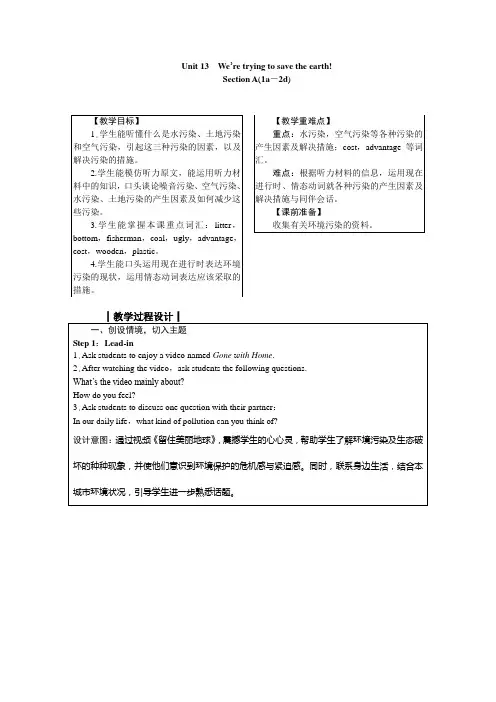
Unit 13We’re trying to save the earth!Section A(1a-2d)┃教学小结┃【板书设计】Unit 13We’re trying to save the earth!Section A(Section A(3a-4c)┃教学小结┃Section B(1a-1e)┃教学小结┃Section B(2a-2e)设计意图:读前预测,为学生在接下来的阅读中获取文章大意作准备。
思维导图可以帮助学生理清文章脉络。
Step 5:Use pictures to teach the new words.When students think about the questions in Step 3,the teacher can write down the new words on the blackboard.And teach them the new words.设计意图:适时呈现词汇,可以减轻学生的阅读压力。
While readingStep 6:Fast reading1.Ask students to look through the article quickly and find out the answer to each question.How many people are mentioned in the passage?Who are they?2.The teacher adds information to the mind-map.设计意图:扫读整篇文章,获取大意,帮助学生把握文章的整体性。
Step 7:Careful reading(Paragraph 2)1.Ask students to read Paragraph 2 carefully and fill in the chart.2.Check answers.3.The teacher adds the information to the mind-map.Step 8:Careful reading(Paragraph 3)1.Ask students to read Paragraph 3 carefully and fill in the chart.2.Check answers.Name What did she make?What materials did she use?Jessica Wong bags old clothes,especially old jeans3.The teacher adds the information to the mind-map.Step 9:Careful reading(Paragraph 4)1.Ask students to read Paragraph 4 carefully and fill in the chart.2.Check answers.Name What did he make?What materials did he use?Wang Tao beautiful art pieces iron and other materials from old cars3.The teacher adds the information to the mind-map.Which things can be done by common people every day?Which things have to be done by governments and organizations?Common people Governments Organizations2.Ask several groups to give a report.设计意图:教师让学生对所学的保护环境的措施进行归纳和分类,培养学生分析问题和解决问题的能力。
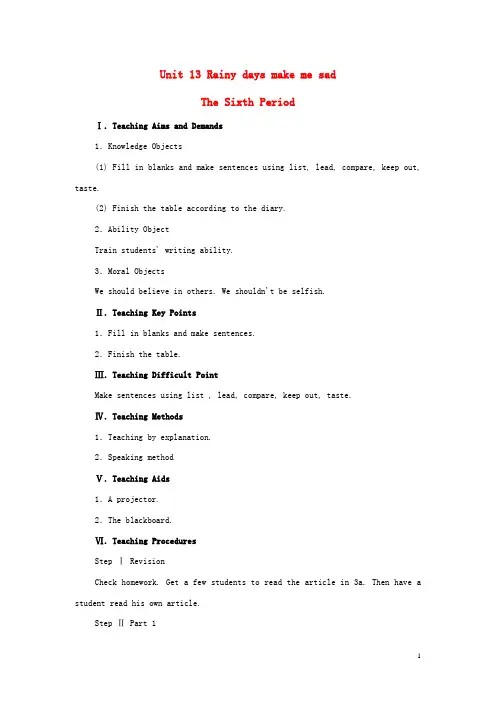
Unit 13 Rainy days make me sadThe Sixth PeriodⅠ.Teaching Aims and Demands1.Knowledge Objects(1) Fill in blanks and make sentences using list, lead, compare, keep out, taste.(2) Finish the table according to the diary.2.Ability ObjectTrain students' writing ability.3.Moral ObjectsWe should believe in others. We shouldn't be selfish.Ⅱ.Teaching Key Points1.Fill in blanks and make sentences.2.Finish the table.Ⅲ.Teaching Difficult PointMake sentences using list , lead, compare, keep out, taste.Ⅳ.Teaching Methods1.Teaching by explanation.2.Speaking methodⅤ.Teaching Aids1.A projector.2.The blackboard.Ⅵ.Teaching ProceduresStep Ⅰ RevisionCheck homework. Get a few students to read the article in 3a. Then have a student read his own article.Step Ⅱ Part 1This activity focuses on vocabulary introduced in the unit.Look at the words in the boo. Get a student to read them. Make sure the students understand the meanings of the words. Please fill in the blanks with the words. In some cases, students may need to use another form of the word, for example adjusting for tense or subject/verb agreement.Get students to fill in the blanks on their own.Check the answers. Five students each read a sentence, filling in the blanks. The rest of the students check their answers. Show the answers on the screen by a projector.1.I need a new jacket. This one doesn't keep out the cold.2.Customers say the food at the restaurant tastes terrible.3.When prices are listed, you can go to the store with the lowest price.4.Working hard at English can lead to a good job.5.Wait before you buy that watch. Let's compare prices in another store.Have students make their own sentences with the words, preferably sentences that are meaningful. Walk around the classroom. Collect a few students' answers with mistakes on the blackboard. Then help students correct the mistakes.Sample answers1.Don't forget to list his name.2.All roads lead to Rome.3.Let's compare your translations with the model translation on the blackboard.4.It's very windy. Please shut the window and keep out the cold.5.Look at the bread. It tastes sweet.Step Ⅲ Part 2This actlvity provides listening and speaking practice using the target language.Go through the instructions for this activity with the class.Get a student to read the diary aloud. Correct any pronunciation errors to make sure the student is providing a good model for the rest of the class. Have students read the diary again. Then ask students to do the work in pairs. When they work, walk around the classroom providing help if necessary.Check the answers with the whole class.AnswersNotes1.home here is an adverb, means at, in or to one's home or country.2.annoy—make rather angry(esp. in passive) , for example, be annoyed with sb.Step ⅣThis activity provides reading and speaking practice with the target language.Ask two students to read the conversation aloud.S A: They make me scared.S B: Really? They make me hungry.Get all the students to read the conversation again. Ask, What makes the cartoon funny? Help students to explain. The second fish is intelligent enough to take the bait from the hook without getting caught.Get some pairs of students to present this conversation to the rest of the class.Notescared—frightenedStep Ⅴ Summary and HomeworkIn this class, we're done much writing practice using the key vocabularywords and the target language presented in this unit.After class, please make sentences with the words in Activity 1 in your exercise books. Then finish off the exercises on pages 55~56 of the workbook.Step Ⅵ Blackboard DesignUnit 13 Rainy days make me sad.Self checkThe Sixth PeriodSample answers to Activity 1:1.Don't forget to list his name.2.All roads lead to Rome.3.Let's compare your translations with the model translation on the blackboard.4.It's very windy. Please shut the window and keep out the cold.5.Look at the bread. It tastes sweet.。
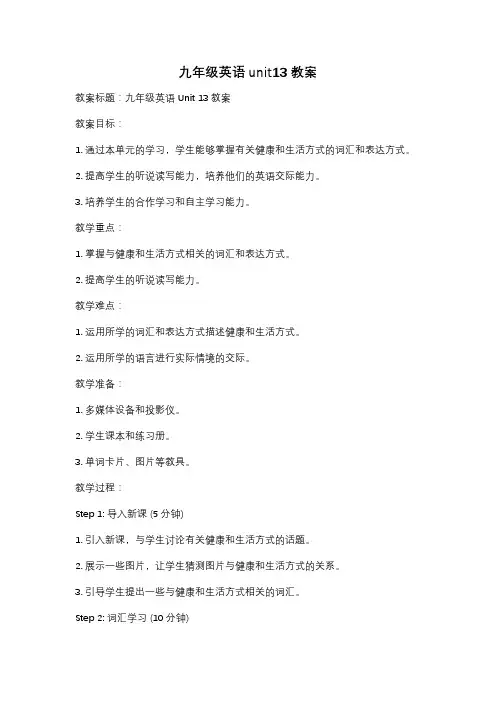
九年级英语unit13教案教案标题:九年级英语Unit 13教案教案目标:1. 通过本单元的学习,学生能够掌握有关健康和生活方式的词汇和表达方式。
2. 提高学生的听说读写能力,培养他们的英语交际能力。
3. 培养学生的合作学习和自主学习能力。
教学重点:1. 掌握与健康和生活方式相关的词汇和表达方式。
2. 提高学生的听说读写能力。
教学难点:1. 运用所学的词汇和表达方式描述健康和生活方式。
2. 运用所学的语言进行实际情境的交际。
教学准备:1. 多媒体设备和投影仪。
2. 学生课本和练习册。
3. 单词卡片、图片等教具。
教学过程:Step 1: 导入新课 (5分钟)1. 引入新课,与学生讨论有关健康和生活方式的话题。
2. 展示一些图片,让学生猜测图片与健康和生活方式的关系。
3. 引导学生提出一些与健康和生活方式相关的词汇。
Step 2: 词汇学习 (10分钟)1. 教师通过多媒体展示单词卡片,教授与健康和生活方式相关的词汇。
2. 学生跟读单词,并进行词汇拼写和语音练习。
Step 3: 阅读理解 (15分钟)1. 学生阅读课本中与健康和生活方式相关的短文,并回答相关问题。
2. 学生进行小组讨论,分享自己的答案,并与其他小组进行交流。
Step 4: 口语练习 (15分钟)1. 学生分成小组,进行角色扮演,模拟真实生活情境,例如在医生办公室里咨询健康问题。
2. 学生互相提问和回答问题,运用所学的词汇和表达方式进行交流。
Step 5: 写作练习 (15分钟)1. 学生根据所给的提示,写一篇关于自己的健康和生活方式的短文。
2. 学生互相交换作文,进行互评和修改。
Step 6: 总结和作业布置 (5分钟)1. 教师总结本节课的重点和难点,并与学生一起回顾所学内容。
2. 布置作业:要求学生完成练习册中与本单元相关的练习。
教学延伸:1. 鼓励学生自主学习,提供相关的阅读材料和网上资源,让学生进一步了解健康和生活方式的话题。

II. 把下面的短语与汉语意思搭配。
1. make a difference A. 参与2. cut down B. 充满3. lead to C. 减少4. be full of D. 起作用5. play a part in E. 导致【重点讲练】1.⑴多指身份、职位等的变化.它强调变化的过程已经完成.后面可接名词或形容词。
er. 他成了一名老师。
⑵get多用于口语.表示一种变化过程.强调的是“渐渐变得”.后常接形容词的比较级形式。
In winter the days get shorter. 冬季白天变得较短。
⑶ turn指在颜色和性质等方面与以前的完全不同.强调变化的结果。
Leaves turned brown in the mountains. 山里的树叶已变成了棕色。
① Her mother ____ angry when she heard the news.②It’s _____ darker and darker outside.③ The milk has _____ bad.2. To cut down air pollution, we should take the bus or subway instead of driving. 为了减少空气污染.我们应该乘坐公共汽车或者地铁.而不是开车。
cut down意为“减少”;是“动词+副词”结构的短语.所带的宾语为名词时.宾语可位于down的前面或后面;为代词时.只能位于down前面。
You’d better cut the article down to about 2,000 words.你最好能把这篇文章压到两千字左右。
【拓展】cut down 还可表示“砍倒”的意思。
T hey cut down the big tree. 他们砍倒了这棵大树。
cut切断;切除off把……切成……cutintocut up 切碎cut in 插队【小试牛刀】单项选择—Did you tell it to Jack?—Yes, but we were ____ in the middle of our telephone conversation.A. cut downB. cut offC. cut upD. cut into3. It’s good for health and it doesn’t cost anything!它对身体有好处并且不会花费任何东西。
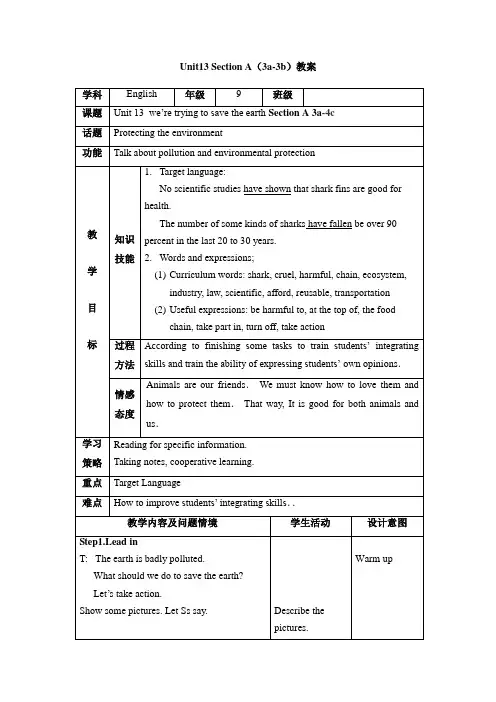
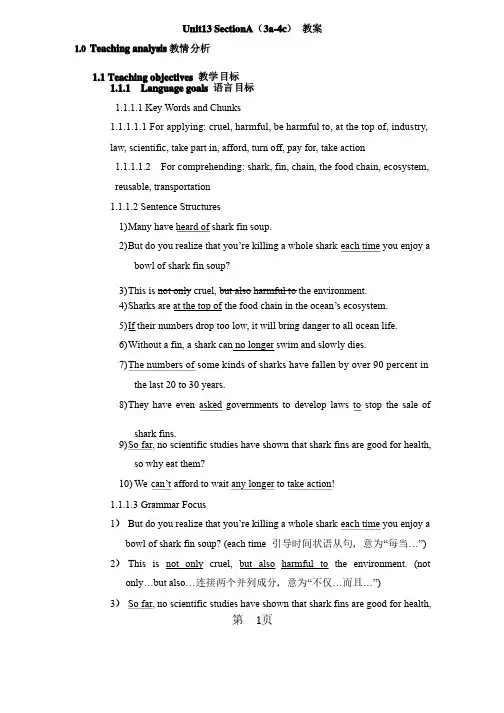
第 1 页 Unit13 SectionA (3a-4c ) 教案1.0 Teaching analysis 教情分析1.1 Teaching objectives 教学目标 1.1.1 Language goals 语言目标1.1.1.1 Key Words and Chunks1.1.1.1.1 For applying: cruel, harmful, be harmful to, at the top of, industry, law, scientific, take part in, afford, turn off, pay for, take action1.1.1.1.2 For comprehending: shark, fin, chain, the food chain, ecosystem, reusable, transportation1.1.1.2 Sentence Structures1) M any have heard of shark fin soup.2) B ut do you realize that you’re killing a whole shark ut do you realize that you’re killing a whole shark each time you enjoy a each time you enjoy abowl of shark fin soup?3) T his is not only cruel, but also harmful to the environment.4) S harks are at the top of harks are at the top of the food chain in the ocean’s ecosystem.the food chain in the ocean’s ecosystem.5) I f their numbers drop too low, it will bring danger to all ocean life.6) W ithout a fin, a shark can no longer swim and slowly dies.7) T he numbers of some kinds of sharks have fallen by over 90 percent in the last 20 to 30 years.8) T hey have even asked governments to develop laws to stop the sale ofshark fins. 9) S o far, no scientific studies have shown that shark fins are good for health,so why eat them?10) We We can’t can’t can’t afford to wait any longer to take action! afford to wait any longer to take action!1.1.1.3 Grammar Focus1) But do you realize that you’re killing a whole shark But do you realize that you’re killing a whole shark each time you enjoy a each time you enjoy abowl of shark fin soup? (each time 引导时间状语从句,意为“每当…”) 2) This is not only cruel, but also harmful to the environment. (notonly…but also…连接两个并列成分,意为“不仅…而且…”)3) So far, no scientific studies have shown that shark fins are good for health,so why eat them? (so far 意为“到目前为止”,是现在完成时的标志)4) Without a fin, a shark can no longer swim and slowly dies. (no longer 意为“不再”,等于not … any longer)1.1.2 Ability goals 能力目标1.1.2.1 To review the present perfect tense and the passive voice.1.1.2.2 To enable Ss to learn some of the key words and expressions in the reading passage.1.1.2.3 To cultivate Ss to read for specific ideas and the structure of the passage.1.1.3 Emotional goals 情感目标1.1.3.1 To help Ss understand the present situation of sharks.1.1.3.2 To raise Ss’ awareness of protecting animals. 1.2 Important and difficult teaching points 教学重难点1.2.1Enable Ss to learn and apply the sentence patterns. 1.2.2 Enable Ss to know the sharks are in danger.1.2.3 Guide Ss to help save the sharks.2.0 Student analysis 学情分析2.1 Fundamental State 基本情况通过本单元第一课时的学习,学生基本上激活了已有的语言知识,对本单元的话题(pollution and environmental protection )已经有所感知,对于environmental problems, how to solve air pollution, how to solve waste pollution 等内容有了更深入的学习。
The Third Period—Section B(1a-1e)Teaching Important Points 【教学重点】Key words & phrases:stop doing sth.,recycle sth.,turn off,paper napkins2.It's hard to stop riding in cars.3.We really shouldn't use paper napkins.Key structure:doing;used to+do;have/has +done;be+done;should+do”.Teaching Difficult Points 【教学难点】★Use the structures to talk about environmental protection in the listenin g and speaking practice.Teaching Aids 【教学工具】A tape recorder,CAI or multimedia courseware.Teaching Steps 【教学过程】★Step 1 Leading in 【新课导入】1.Greeting2.BrainstormingAsk these questions:What can we do to help our environment?How can we help to stop air/land/water pollution?What can we do at school?3.Practice with more students.★Step 2 Cooperative inquiry 【合作探究】1.Finish the task in 1a①Play videos about environment to lead the students into the lesson.②Get the students to make a list of the ways of what we can do to save the earth,using the results of the discussion at step 1.Then say in which ways they have done well.③Read the items in 1a and rank them from 1 to 5.2.Finish the task in 1b①T:Do you often do these to help the earth?Talk with each other.②Ask different students to say out their sentences in class.3.Finish the task in 1c①Read the introduction of 1c and read the phrases in the first column.Learn the meaning of them.②Play the recording for the first time.Students check the things that Julia and Jack talkabout.Check the answers with the class.4.Finish the task in 1d①Read the introduction of 1d.Play the recording for the second time.②Get the students to finish the task in 1d.③Play the recording once more.Students repeat and check the questions.④Check.Ask the students to say out the complete sentences.5.Finish the task in 1e①Read aloud the conversation.Then ask a few pairs to role-play the conversation.②Read the example conversation in 1e.Then students work in pairs.Role-play.③Ask three pairs to say out their conversations to the class.④Write their conversations in the exercise books.★Step 3 Homework1.Make conversations about saving the earth with other students after class.2.Write a conversation to talk about what we can do to help the environment.3.Translate the following sentences into English.(1)那女孩以前用纸巾。
新⽬标英语九年级Unit13全单元教案Unit 13 Rainy days make me sad.Part 1: Teaching designSection AGoals●To learn to use make/s me+infinitive, make/s me+adjective●To listen and talk about eating in a restaurantProceduresWarming up by learning to use make/s me+infinitive, make/s me+adjective On page 103 is the grammar focus chart. Read the three sentences and try to understand its structure.Now you are supposed to make as many sentences with themake/s me+infinitive, make/s me+adjective structure as possible.1a Looking and sayingOn page 102 is a picture of restaurants. Which one would you like to go? And why?1b Listening and completingListen to a conversation between Amy and Tina talking about eating in restaurants. While listening, pay attention to the“make/s me +infinitive, make/s me +adjective structure” .And now complete the unfinished sentences in the chart on page 102.Now you are supposed to read the tapescript. While reading, underline the expressions1c Doing pairworkWhat are your opinions about the two restaurants? Which on would you like better?2a Listening and numberingA boy and a girl are talking about their past experiences. Listen to their talk and number the pictures on page 103.2b Listening and checkingYou are supposed to listen to the conversation once again. Before you listen, go over the seven sentences said by Tina and John in the box on page 103. While you listen, check √the things said by them respectively. After you listen, check your answers against each other’s.All right now, you are supposed to read the tapescript. WhileReading, try to the “make/s me +infinitive, make/s me +adjective structure”, underline the expressions and blacken the connectives.2c Doing pairworkGo over the activities in 2a and 2b. Then in pairs try to role play the conversation between Tina and John. You may make use of the examples on page 103 to begin with.3aReading and answeringOn page 104 is an article about restaurant science. Before you read, imagine just what a restaurant science is. While you read, try to divide the sentences into parts, underline the expressions and, blacken the connectives and circle the “make/s me+infinitive, make/s me +adjective” structure.Now you are to answer the three questions on page 104 in the box.3b Doing groupworkNow le t’s play a game. Tell your group members about a place you know well. Let them try to guess the name of the place.4 Completing and surveying1) How do you feel about pollution ?2) It makes me kind of angry. How about you?3)Closing down by looking and sayingSECTION BGoals●To learn to use make/s me+infinitive, make/s me+adjective structures ●To listen, talk and read about productsProceduresWarming up by playing a gameGood morning, class. It is so cold today. The weather heremakes me sad. Now let’s first play a game to make us happy. We shall try to say as many sentences with make/s me+infinitive, make/s me+adjective structures as possible. The one who says the most such sentences will be made the monitor for today!1a looking and matchingOn page 105 are four pictures of daily products. Now read, think, and match them with the slogans in the box.1b Making a listIn our life we use lots of products every. Which ones do you like best, and which ones do you not like? Now make a list of them, three for each choice.2a Listening and tickingYou are going to listen to a conversation about products used in daily lives. Before you listen, go to page 105 and read the names of the products and the comments in the chart.After you listen, tick the products they like, and kick out the ones they don’t.2b Listening and drawingNext you are to listen and draw to show what the people say about the products. Finally go on to read the tapescript to learn some expressions and the make/s me +infinitive, make/s me +adjective structures.2c Doing groupworkIn 1b you have made a list. Now to practice spoken English you are to make use of the list making a conversation with your group members.3a Reading to decideOn page 106 you will find article talking about advertising.Before you read, guess at the ideas to be talked about in the article. While you read,underline the expressions, blacken the connectives the examples of the make/s me +infinitive, make/s me +adjective structures.After you read, decide if you agree with the author or not.3b Reading and completingOn page 106 in the center is an unfinished article. Read it and try to complete it using the information about two or more products in activity 2a.3c Looking and writingAfter you read, you are to write! Now go back to page 105 to write slogans of your own with the help of the slogans of theirs there on page 105.4 Doing pairworkIn pairs discuss how the posters on page 106 make you feel.Closing down by drawing your own postersAt the end of the period we shall do something interesting: weshall draw pictures or posters. To advertise your products or services you have to draw posters. Now let’s wait and see whose products of posters are the most attractive and persuasive!SEFL CHECK1 Reading and fillingTo do something boring, go to page 107 and read the 5 sentences in the box. Complete them with a correct word given in its correct form. OK?2. Reading and writingIn the center of page 107 is a diary. Now you are given the right to read this diary by Ming. While reading keep your eyes on the structures and expressions. You know how important structures and expressions are for learning English.Dear Diary, 28, JuneI thoughttoday was going to be really bad. To start with, it was raining, and rainy daysmake me sad. And it was my birthday, butwhen I got up, no one was at home, and Mo m and Dad hadn’t left me a note. I walked to school with my best friend, Gu. She didn’t say anything either. This made me a little angry. After all, I remembered her birthday last month. In class, the teacher asked me for my homework, butas I was so tense when I left home, I had forgotten to bring it with me. That made me annoyed with myself. But things got better. Gu invited me for lunch. I was so surprised. Mon and Dad and all my friends were there. I had a wonderful surprise birthday lunch. That made me VERY happy.Early morning Late morning Noon Lunch timesad A little angry annoyed surprisedJust for fun!Looking at theposters above andwrite ad slogans forthem.Reading: Receiving money makes me uncomfortable.Before you read, go to the vocabulary list for this part on page 155. Read the words and study the word formation for meanings.While you read, blacken the predicates and circle the connectives.Receiving money makes me uncomfortable.Many books have been written about “the art of giving”. But what about the art of receiving? Sometimes, receiving a gift can be difficult, especially when someone buys you a giftyou d on’t want!“I remember when I was about twelve years old, my parents bought me a purple purse,”laughs Guo Xiaojing. “It really made me feel embarrassed, because to be honest, I thought the purse was really ugly!Still, I pretended that I liked it because IPart 2: Teaching Resources (第⼆部分:教学资源)I. What is a poster?A poster is any large piece of paper which hangs from a wall or other such surface. They are a frequent tool of advertisers, propagandists, protestors and other groups trying to communicate a message, and they also see personal use by people, especially the young, who wish to decorate in a relatively low-cost manner.II. Some wonderful slogans of advertisementsTrust me, you can make it. (美容)Human technology. (Nokia)When there is no tomorrow. (联邦快递)The milk chocolate that melts in your mouth-not in your hand. (巧克⼒)Good to the last drop. (雀巢咖啡)Next to myself, I like BVD best. (BVD内⾐)Just do it. (运动鞋)Things go better with coke. (可⼝可乐)One card, all the possibility. (Visa)MasterCard. Master the shopping possibility. (Card)It's everywhere you want to be. (Visa)Don't leave home without it. (美国通卡)Ugly is only skin-deep. (汽车)Shape up your image, future and life.Natural is beautiful. (美容)Gifted photographers require beautiful print quality.Using your own way to enjoy working; It's no price. (信⽤卡) Everything we do is driving by you. (汽车)Travel by air without any reservation. (鞋⼦)A diamond is forever. (钻⽯)We do chicken right. (炸鸡)No matter how you look at typing, we are your type. (打字机) The taste that refreshes. (饮料)Nokia connection people. (Nokia)Makoto Bank. Making communities together. (银⾏)Ford has a better idea. (Ford)Save our mouth for Memtos. (⾷品)It's Finger Licking good./we all do it for you. (快餐)Are you in or out? (美语补习班)Keep walking. (酒类)We share. (寿险)Made to move. (Nike)We're family. (信⽤卡)Forever sport. (Adidas)Just call me, be happy. (⼤哥⼤)So charming, so easy. (化妆品)Air France-making the sky best place on earth. (航空)Your favorite spare for your pleasure and dream. (动画商品) It's been a long hard road without you on the mind. (汽车)。
Unit 13 We’re trying to save the earth!教师寄语Saving the earth is saving ourselves.学习目标:1.知识目标:掌握本部分的单词、短语、句型和语法2.能力目标:能熟练自如地描述相关话题。
3.情感目标:通过小组活动和合作,在多种英语学习情景中用英语交流。
重难点:本单元相关语法点的掌握及运用。
学习过程:壱.Greetings弐.Go over the wordsⅠ.K e y w o rd s(1)1.l itter (同义词)2.b ottom (反义词)3.f isherman (复数)4.u gly (反义词)5.a dvantage (反义词)6.c ost (过去式)(过去分词)7.w ooden (名词)8.s cientific ( 科学)(科学家)9.c reativity (形容词)(动词)10.harmful (名词)Ⅱ.K e y w o rd s(2)1.煤11.塑料的2.方法12.鲨鱼3.残忍的13.生态系统4.工业,行业14.可重复使用的5.买得起15.交通,运输6.总统,负责人16.法律7.作品17.餐巾纸8.瓶子18.灵感,榜样9.大门19.金属10.回收使用20.鱼鳍三.Do some exercise about wordsWe should put up notice to stop from (乱扔)。
2.The teacher asked us to find a way to pick up the coinsat the (底部)of the bottle.3.There are no more fish for (渔夫)to catchin the river.4.We should take the paper bags to go shopping insteadof the (塑料)ones.5.Could you please tell us another (优点)ofriding bike to work?四.Review some phrasesII.Phrase:1.充满2.扔进3.在……发挥作用4.扔掉5.减少6.起作用;有影响7.导致,通向8.切除9.不但……而且……10.对……有害11.在……顶部或顶端12.上下颠倒13.参加14.恢复,使想起15.关掉16.付费;付出代价17.有一个创新的头脑18.采取行动19.好好利用20.拆下,摧毁21.创建,建立22.因……而著名23.用……建成五.Language points小组合作讨论并完成练习六.本单元语法复习教师讲解复习讨论七.中考链接,挑战中考八.Homework保护人类共同的家园—地球是每个人的责任和义务。
新版人教版九年级英语Unit13全单元公开课教案共16页ask them what they see。
Then。
ask them to predict what the article will be about based on the pictures.1b。
Play the recording and ask students to listen carefully for the target language and useful ns。
Have them take notes and then discuss their findings in pairs or small groups.1c。
Have students work in pairs or small groups to discussthe ns and prompts related to the article。
Encourage them to usethe target language and useful ns in their ns.The topic of this lesson is protecting the environment。
specifically focusing on n and environmental n。
The target language includes phrases such as "We're trying to save the earth" and "Everyone should help to clean up the river." The grammar covered includes present progressive。
used to。
and modal verbs。
nally。
students will learn new vocabulary words such as "litter," "bottom," and "fisherman."The teaching methods used in this lesson include listening for key words。
Unit13 SectionB(3a-Self Check)教案1.0教情分析1.1 Teaching objectives教学目标1.1.1 Language targets 语言目标1.1.1.1Key Words and Chunks1.1.1.1.1 For applying: solve the problem, worse and worse, give suggestions1.1.1.1.2 For comprehending: fame, inspire1.1.1.2Sentence Structures1)What or who is causing these problems?2)Which parts need to be improved?3)People should take public transportation more.4)The air pollution is getting worse and worse.1.1.1.3Grammar Focus1)The air pollution is getting worse and worse.(worse and worse 意为“越来越糟糕”)2)Which parts need to be improved? (need to be improved意为“有必要改进”)1.1.2 Ability goals 能力目标1.1.2.1 引导学生全面浏览性复习,总结归纳环境污染及保护的表达。
1.2.2.2 学会用同伴商讨交流,达到共同完善与提高。
1.2.2.3培养学生发散思维,通过写作练习帮助学生建构话题表达的框架体系。
1.1.3 Emotional goals 情感目标1.1.3.1 培养学生小组合作意识。
1.1.3.2 鼓励学生积极交流,互相借鉴参考,取长补短。
1.2 Important and difficult teaching points 教学重难点1.2.1 准确使用目标语言进行写作表达。
Unit 13 We’re trying to save the earth!Section A 3a—3c一、知识目标:1.学习并掌握新词汇:shark, fin, method, cruel, cut off, harmful, chain, ecosystem, low, industry, law, environment, environmental, scientific2. 学会并正确使用以下常用表达:hear of, cut off, throw…in to, no longer, no t only…but also, be harmful to, at the top of the fo od chain, the sale of… ,ask sb. to do sth., so far, be good for, be against, in danger3. 学会使用以下句型:(1)Do you realize that you’re killing a whole shark each time you enjoy a bowl of shark’s fin soup?(2)When people catch sharks, they cut off their fins and throw the shark back into the ocean.(3)This method is not only cruel, but also harmful to the environment. (4)The numbers of some kinds of sharks have fallen by over 90 percent in the last 20 to 30 years.(5)They have even asked governments to develop laws to stop the sale of shark’s fins.二、能力目标:通过文段阅读,提高阅读理解能力。
九年级英语unit13教案【篇一:九年级英语第十三单元教案unit 13 we】unit 13 we’re trying to save the earth!一、教学目标:1. 语言知识目标基本词汇:litter, advantage, bottom, fisherman, coal, ugly, cost, wooden, plastic, takeaway, bin,shark, fin, method, cruel. harmful, chain, ecosystem, industry, law, scientific, afford,reusable, transportation, recycle, napkin, upside, gate, bottle, president, inspiration,iron, work, metal, creativity,基本词组:be harmful to, at the top(of sth.), take part in, turn off, take action, throw away, put sth.to good use, pull… down, bring back基本句型:we’re trying to save the earth! the river used to beso clean.the air is badly polluted. no scientific studies have showedthat shark fins are good for health.we should help save the sharks.2. 技能目标: 能正确运用现在进行时,现在完成时,被动语态,情态动词和used to 句型。
3. 情感目标: 有环境危机意识,学会关注环境保护环境。
二、教学重难点:1. 教学重点:(1)能正确运用现在进行时,现在完成时,被动语态,情态动词和used to 句型。
(2)保护环境的措施方法。
2. 教学难点:能正确运用现在进行时,现在完成时,被动语态,情态动词和used to 句型。
三、教学步骤:unit 13 section a 1 (1a-2d)i. presentationshow the picture of the earth and tell students the earth is polluted now.for example: (1) the factories that burn coal pollute the air with a lot of black smoke.(2) factories put waste into the river.(3) people should throw away litter in the bin.(4)there are more cars on the road.ii. learninghere are some words related to different kinds of pollution. write them in the box below. then add more words.____________ ____________________________________ ____________________________________ ____________________________________ ________________________keys : noise pollution:loud music planesmobile phonesbuilding housesair pollution:factories smokingcarsbuilding houseswater pollution:shipsrubbish litteringfactoriesiii. listeningclean up2. listen again and check (√) the sentences you hear.1) we could go fishing in the river.2) the river was really dirty. 3) the river has always been the nicest river in this town. 4) we should ask the teachers for help. keys: 2 3iv. practice1. role-play the conversation in 1c.mark: the river was dirty. even the bottom of the river was full of rubbish.tony: but it used to be so clean!mark: yes, but people are throwing litter into the river.tony: everyone in this town should play a part in cleaning it up!2. make conversations using the pollution in 1a.a: the river has always been the nicest river in this town.b: yes, it used to be so clean.a: but i was there last weekend and the river was really dirty.b: what caused the problem?a: people are throwing litter into the river.b: what should we do?a: factories are also putting waste into the river.b: yes, everyone in this town should play a part.a: we should write to the government and ask them to close down the factories.b: what else can we do?a: everyone should help to clean up the river.v. language points1. we’re trying to save the ear th! 我们正在竭尽全力拯救地球!try to do =try one’s best to do 努力去做某事。
e.g. every student should try to study hard in order to study in a university.为了进入大学学习,每个学生都应该努力学习。
2. here are some words related to different kinds of pollution.be related to 与…有关e.g. i am not related to him in any way. 我和他无任何关系。
3. everyone in this town should play a part in cleaning it up!play a part in在……方面起作用e.g. a good diet plays a large part in helping people live longer. 健康饮食在帮人们长寿方面起着非常大作用。
play a part 在……中扮演角色e.g. he was invited to play a part in this tv play. 他被邀请参加这个电视剧的演出。
4. even the bottom of the river was full of rubbish.yes, but people are throwing litter into the river.litter 和 rubbish 都可指“垃圾”,用作不可数名词。
rubbish 指“没用的东西(被扔或将要丢弃的无用的东西)”不可回收。
litter 指“(室内或公共场所)乱扔的废物(纸屑、不要的包装纸、废瓶等)”还可回收e.g. throw the rubbish out. 把垃圾扔出去。
the room is full of rubbish. 房间里堆满了垃圾。
pick up your litter after a picnic.野餐后将废弃物收拾好。
vi. listening1. 2a listen to the interview. circle the kinds of pollution that jason and susan talk about.a. land pollutionb. air pollutionc. noise pollutiond. water pollutionkeys: b a2. 2b listen again and complete the sentences.1) the air is badly polluted because there are ___________ on the road these days.2) factories that burn coal also ________ the air with a lot of black smoke.3) there is also too much rubbish and waste. people_________________ things every day.4) people are also littering in ______________ like parks. this is turning beautiful places into ugly(丑陋) ones.keys: more carspolluteare throwing awaypublic places3. listen and answer the questions.1) who is the interviewer talking to?2) what are they talking?3) what other problems do they see?keys: susan and jason. the environmental problems. there’s too much rubbish and waste in the streets.vii. practice (2c)use the information in 2a and 2b to role-play conversations between jason and susan.jason: the air has become really polluted ar ound here. i’m getting very worried.susan: yes, i used to be able to see stars in the sky.jason: the problem is that…viii. discussionask students what we should do to save the earth. help students answer, turn off thelights when you leave a room; stop riding in cars; stop using paper towels or napkins; recycle books and paper.ix. readinginterviewer: jason and susan, what are your ideas for solving these problems?jason: well, to cut down air pollution, we should take the bus or subway instead of driving.susan: yeah, or ride a bike. there are other advantages (优点) of bike riding. it’s good for health andit doesn’t cost (花费) anything!interviewer: great ideas! what about waste pollution?susan: mmm, i think simple things like bringing a bag to go shopping can help. i started doing that ayear ago.jason: me, too. also, i never take wooden chopsticks or plastic (塑料) forks when i buy takeaway (外卖食品) food. i use the ones at home.susan: and remember to throw rubbish in the bins and keep public places clean and beautiful foreveryone.interviewer: so together, our actions can make a difference and lead to a better future!x. summary and language points1. this is turning beautiful places into ugly ones.turn… into… 把……变成……e.g. the icy rain seemed like to turn into snow.渐渐地冻雨又变成雪花的模样。